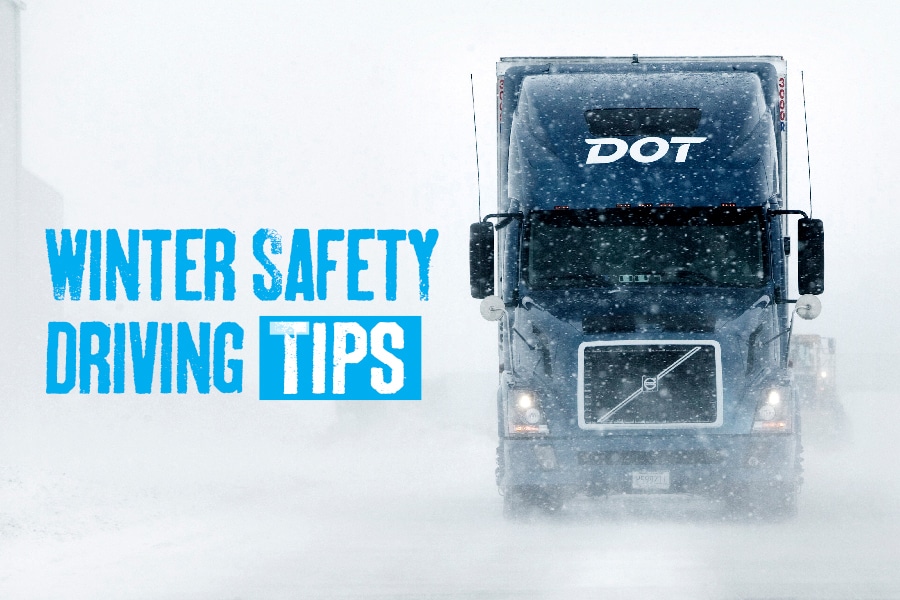This winter has not disappointed anyone when it comes to rain, sleet, and snow. 2019 has been one of the worst winters in history in terms of precipitation and cold temperatures.
We’ve talked about how to avoid the slips and falls of winter when you’re walking outside, but what about on the roads?
Unfortunately, those elements make roads dangerous and sometimes altogether impassable and can greatly affect winter truck driving safety. Limited or reduced visibility and traction are among the most frequent reasons for winter weather-related accidents. As professional drivers, we need to compensate for other drivers’ bad habits and decisions by using the Smith System.
What is the Smith System?
The Smith System is based on the Smith5Keys. According to Smith System, these keys are “designed to provide drivers with the knowledge and skills to create three important things while driving: Space… visibility… and time.”
Space
Space is required to maneuver your vehicle away from potentially dangerous situations.
Visibility
You need enough visibility to thoroughly scan the area around you and be able to react to potential conflict with other vehicles or objects in time to prevent an accident.
Time
Give yourself adequate time to react to difficult driving environments.
Applying the Smith5Keys to Winter Truck Driving
1. Aim High in Steering
Be aware of wind gusts, especially coming out of a windbreak, such as an overpass, a bank of trees, and bridges.
2. Get the Big Picture
Slowing down and making gentle movements can compensate for poor traction.
3. Keep Your Eyes Moving
Use low beam headlights when the snow is falling or blowing. “Snow hypnosis” is caused when you travel directly into heavy snowfall and begin to stare at the flakes. Keep your eyes moving—scan the instrument cluster, check your mirrors, scan from ditch to ditch if possible.
4. Leave Yourself an Out
Allow a safe following distance—about 8 to 10 seconds—between you and the vehicle in front of your truck. Avoid driving right next to another vehicle if possible.
5. Make Sure They See You
Keep everything clean, so you can be seen. When you’re able to stop in a safe place, clean the snow and ice from your tractor and trailer lights to keep them clear. LED lights, while more energy efficient, tend to accumulate snow because they do not generate enough heat to melt it off.
Additional Winter Driving Safety Tips
- Check weather forecasts and possible construction areas along your route. Allow yourself extra time to avoid the rush mentality—with increased speed comes a higher risk of an accident.
- It is important always to do a walk-around vehicle inspection; check tires, wiper blades, fluids, lights, and defroster. Have extra wiper blades and windshield wiper fluid with you at all times.
- Avoid driving in other vehicles’ tracks. You will have more traction in the fresh undisturbed snow.
- Black ice can fool drivers into thinking it is water. Keep an eye out under bridges and overpasses, and in shady spots and intersections where it’s likely to form.
- Turn off the engine brake and cruise control. Using them on slick roads can lead to a jackknife.
- Before exiting your truck and while still sitting in your seat, make it a habit of running your foot across the top step to check for ice.
Taking Control of Your Driving Safety
You are the captain of your ship, and you make all the decisions. You can never be too careful when driving in the winter.
The best truck driving safety tip applies year-round, on the road and off—never put yourself into situations where you aren’t comfortable.
If the conditions are too dangerous, make the safe decision to get off the road. Let your dispatch team know so that they can re-schedule your appointments.
Following the Smith5Keys will help you feel more at ease and secure behind the wheel. Safe travels this winter!
Have some of your own winter truck driving safety tips we missed? Looking to drive with a company that prioritizes safety? Let us know!


